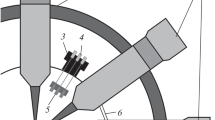Abstract
In the framework of the 14-band k • p model, the intensity of the impact ionization processes in direct gap semiconductors is studied and explicit expressions for the impact ionization rate are obtained. It is shown that the rate of the process near the threshold energy is determined by the sum of the isotropic and strongly anisotropic contributions. The former contribution is proportional to the cube of the distance from the threshold, whereas the latter is a quadratic one arising only because of the coupling with remote bands. The comparison of these contributions under averaging over the nondegenerate isotropic distribution of nonequilibrium electrons characterized by some effective temperature T* demonstrates that the cubic contribution rather than the commonly used quadratic one is dominant in the direct gap semiconductors with E g<1−1.5 eV up to T* = 300 K. This should be taken into account in the calculations of the operating characteristics of the devices based on the avalanche multiplication of charge carriers.
Similar content being viewed by others
References
S. M. Sze and K. K. Ng, Physics of Semiconductor Devices, 3rd ed. (Wiley, New Jersey, 2007).
K. Gopalakrishan, P. B. Griffin, and J. D. Plummer, IEEE Trans. Electron. Dev. 52, 69 (2005).
V. N. Abakumov, V. I. Perel’, and I. N. Yassievich, Nonradiative Recombination in Semiconductors (Peterb. Inst.Yad. Fiz. AN, St.-Petersburg, 1997, North-Holland, Amsterdam, 1991).
L. V. Keldysh, Sov. Phys. JETP 10, 509 (1959).
K. Y. Choo and D. S. Ong, J. Appl. Phys. 96, 5649 (2004).
D. Harrison, R. A. Abram, and S. Brand, J. Appl. Phys. 85, 8186 (1999).
B. Gelmont, K. Kim, and M. Shur, Phys. Rev. Lett. 69, 1280 (1992).
A. P. Dmitriev, M. P. Mikhailova, and I. N. Yassievich, Phys. Status Solidi B 140, 9 (1987).
G. G. Zegrya and A. S. Polkovnikov, J. Exp. Theor. Phys. 86, 815 (1998).
C. L. Anderson and C. R. Crowell, Phys. Rev. B 5, 2267 (1972).
R. Winkler, Springer Tracts in Modern Physics 191 (2003).
E. O. Kane, J. Phys. Chem. Solids 1, 249 (1957).
A. A. Greshnov, Yu. B. Vasil’ev, N. N. Mikhailov, G. Yu. Vasil’eva, and D. Smirnov, JETP Lett. 97, 102 (2013).
Author information
Authors and Affiliations
Corresponding author
Additional information
Original Russian Text © A.N. Afanasiev, A.A. Greshnov, G.G. Zegrya, 2017, published in Pis’ma v Zhurnal Eksperimental’noi i Teoreticheskoi Fiziki, 2017, Vol. 105, No. 9, pp. 554–558.
Rights and permissions
About this article
Cite this article
Afanasiev, A.N., Greshnov, A.A. & Zegrya, G.G. Impact ionization rate in direct gap semiconductors. Jetp Lett. 105, 586–590 (2017). https://doi.org/10.1134/S0021364017090065
Received:
Published:
Issue Date:
DOI: https://doi.org/10.1134/S0021364017090065




